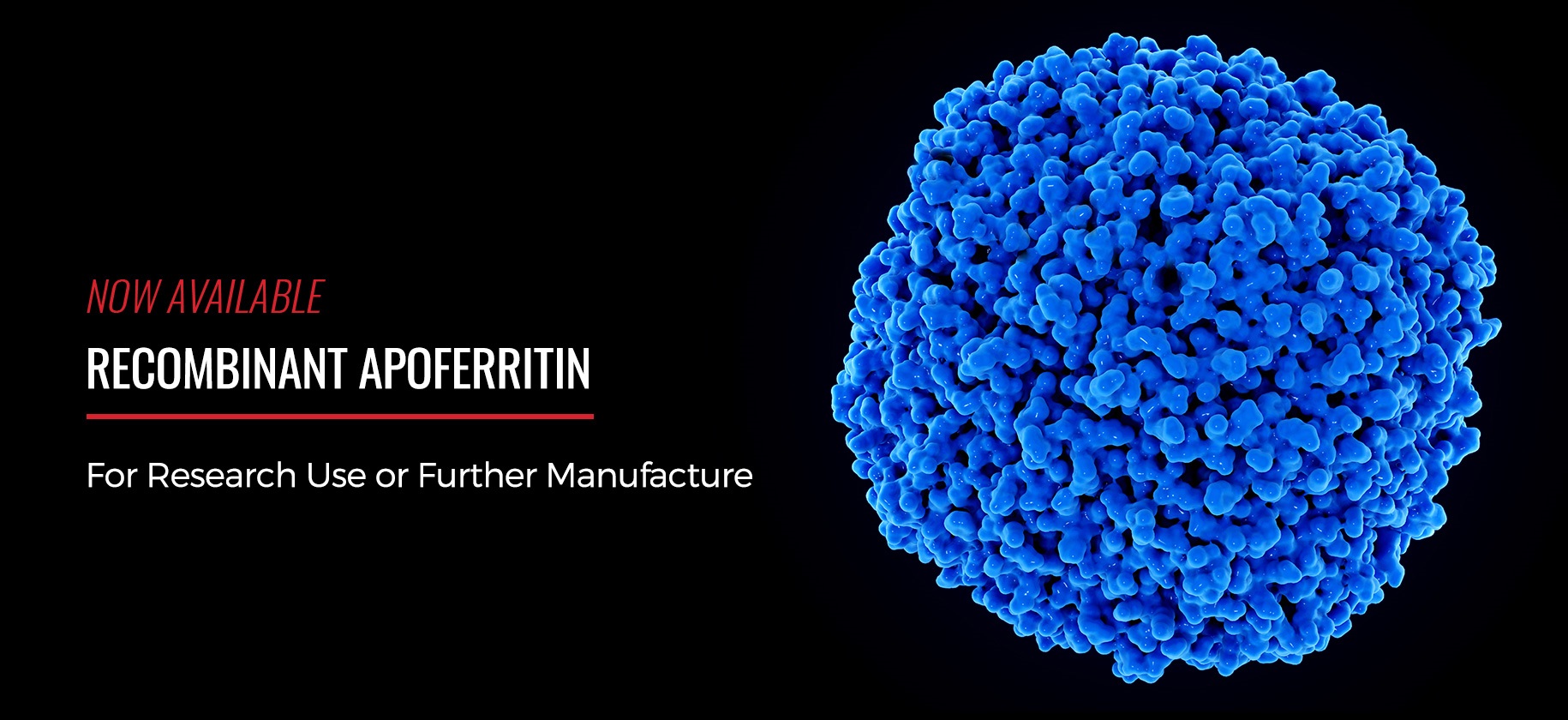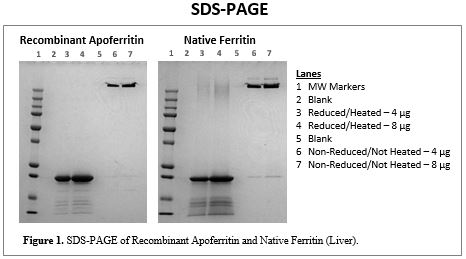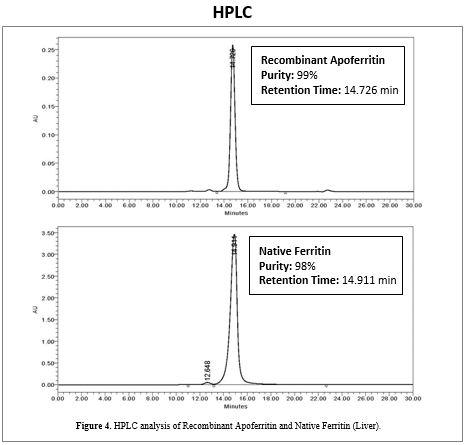Recombinant Apoferritin

Recombinant Apoferritin - ≥95% | View Recombinant Apoferritin Data (as PDF)
With native raw materials in increasingly short supply, recombinant proteins will be called on to replace native proteins with greater frequency in the clinical diagnostic industry. The transition to a recombinant can be a daunting task and one that is complicated and time-consuming. The validation processes, both internal and external, must be well designed and thorough, in an effort to demonstrate conclusively that the recombinant product is a suitable replacement for the native protein.
We present here data comparing Recombinant Apoferritin with Native Ferritin: The two ferritin products demonstrate analogous physical characteristics and similar reactivity in multiple antibody-based assay systems.
SDS-PAGE
Figure 1 presents SDS-PAGE images of Recombinant Apoferritin, Mat. No. F1021-90659, and Native Ferritin (Liver), Mat. No. F0325-90563. Analysis of the gels reveals a comparable molecular weight profile between Recombinant Apoferritin and Native Ferritin, under reduced/heated and non-reduced/not heated conditions.

WESTERN BLOT
Recombinant Apoferritin and Native Ferritin are 24-subunit molecules, comprised of a variable mixture of heavy-chain and light-chain ferritin. Figure 2 shows Western Blot analyses of Recombinant Apoferritin and Native Ferritin. The staining patterns of both ferritin products show the expected molecular weight variants, identified by a monoclonal antibody specific for whole molecule ferritin.

To demonstrate the presence of the heavy-chain and light-chain ferritin subunits, Figure 3 shows Recombinant Apoferritin and Native Ferritin, stained with an antibody specific for heavy-chain ferritin and with another antibody specific for light-chain ferritin. The blot on the left was stained with a monoclonal antibody specific for heavy-chain ferritin. The blot on the right used a monoclonal specific for light-chain ferritin. Together, the blots demonstrate the presence of heavy-chain and light-chain ferritin subunits in both Recombinant Apoferritin and Native Ferritin.

HPLC
Analysis of the HPLC elution profiles for Recombinant Apoferritin and Native Ferritin reveal very similar retention times and peak shapes, demonstrating comparable molecular weights and levels of purity between the two ferritin products. Recombinant Apoferritin eluted at 14.726 minutes, while Native Ferritin eluted at 14.911 minutes. The difference between these retention times is <2%, which is well within assay-to-assay and lot-to-lot variation. This indicates the molecular weights of Recombinant Apoferritin and Native Ferritin are nearly indistinguishable. The purity levels of the two ferritin products are also virtually identical. Recombinant Apoferritin registers 99% purity and Native Ferritin 98%.

CLINICAL IMMUNOANALYZER
Perhaps the most critical analysis of a recombinant protein, in consideration for its replacement of the native protein, is performance on a commercial clinical immunoanalyzer. Like-for-like, reproducible assay results are the optimal outcome when evaluating a recombinant in any clinical diagnostic assay system.
As is seen in Table 1, the correlation for Recombinant Apoferritin, Recombinant Ferritin, and Native Ferritin between two different clinical immunoanalyzers is excellent. Each ferritin product gave nearly identical results between the two assay platforms. Recovery ranged from 101% to 107%, which is well within expected assay variation. Assays were run in duplicate.

Of note, Recombinant Ferritin was included in the clinical immunoanalyzer analyses. It was produced by saturating Recombinant Apoferritin (ferritin without iron) with iron as part of an iron-uptake study conducted in our laboratory.
Collectively, these results demonstrate a remarkable similarity between Recombinant Apoferritin and Native Ferritin. We have presented data on molecular weight, subunit composition, and antibody reactivity in western blot and clinical immunoanalyzer platforms. We understand you need to evaluate Recombinant Apoferritin in your own system, but we hope the data presented here will give you the confidence we have that Recombinant Ferritin is a more than suitable replacement for Native Ferritin.
Recombinant Apoferritin is in stock and available now:
